Analysis of Monopoly and Monopolistic Competition in Australia
VerifiedAdded on 2023/06/08
|11
|2517
|350
Report
AI Summary
This report provides a comprehensive analysis of monopoly and monopolistic competition within the Australian market. It begins with an introduction defining these market structures, followed by a detailed analysis of their characteristics, including graphical representations of equilibrium and profit scenarios. The report then explores examples of monopolies and monopolistic competition in Australia, such as the Australian Post, mining sector, and various coffee and telecommunication companies. It examines the advantages and disadvantages of monopoly power, and discusses the role of government intervention, including the Trade Practices Act and public ownership. The report concludes by assessing the effectiveness of government policies in promoting consumer welfare, particularly in the energy industry, and suggests alternative strategies such as lump-sum taxes and average cost pricing. The report highlights the importance of understanding market dynamics to improve consumer welfare and addresses the need for revised policy prescriptions to mitigate the negative impacts of monopolies.
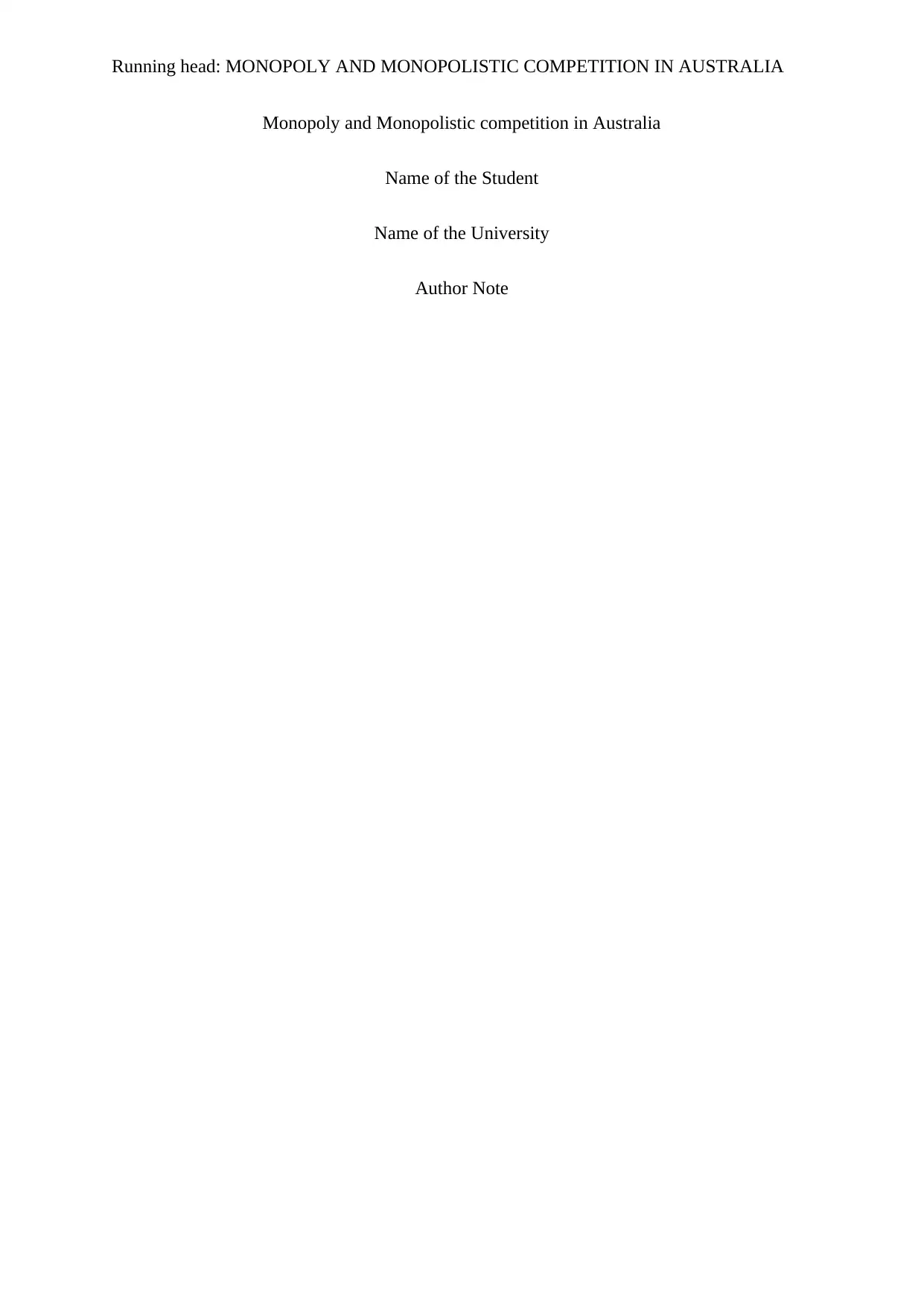
Running head: MONOPOLY AND MONOPOLISTIC COMPETITION IN AUSTRALIA
Monopoly and Monopolistic competition in Australia
Name of the Student
Name of the University
Author Note
Monopoly and Monopolistic competition in Australia
Name of the Student
Name of the University
Author Note
Paraphrase This Document
Need a fresh take? Get an instant paraphrase of this document with our AI Paraphraser
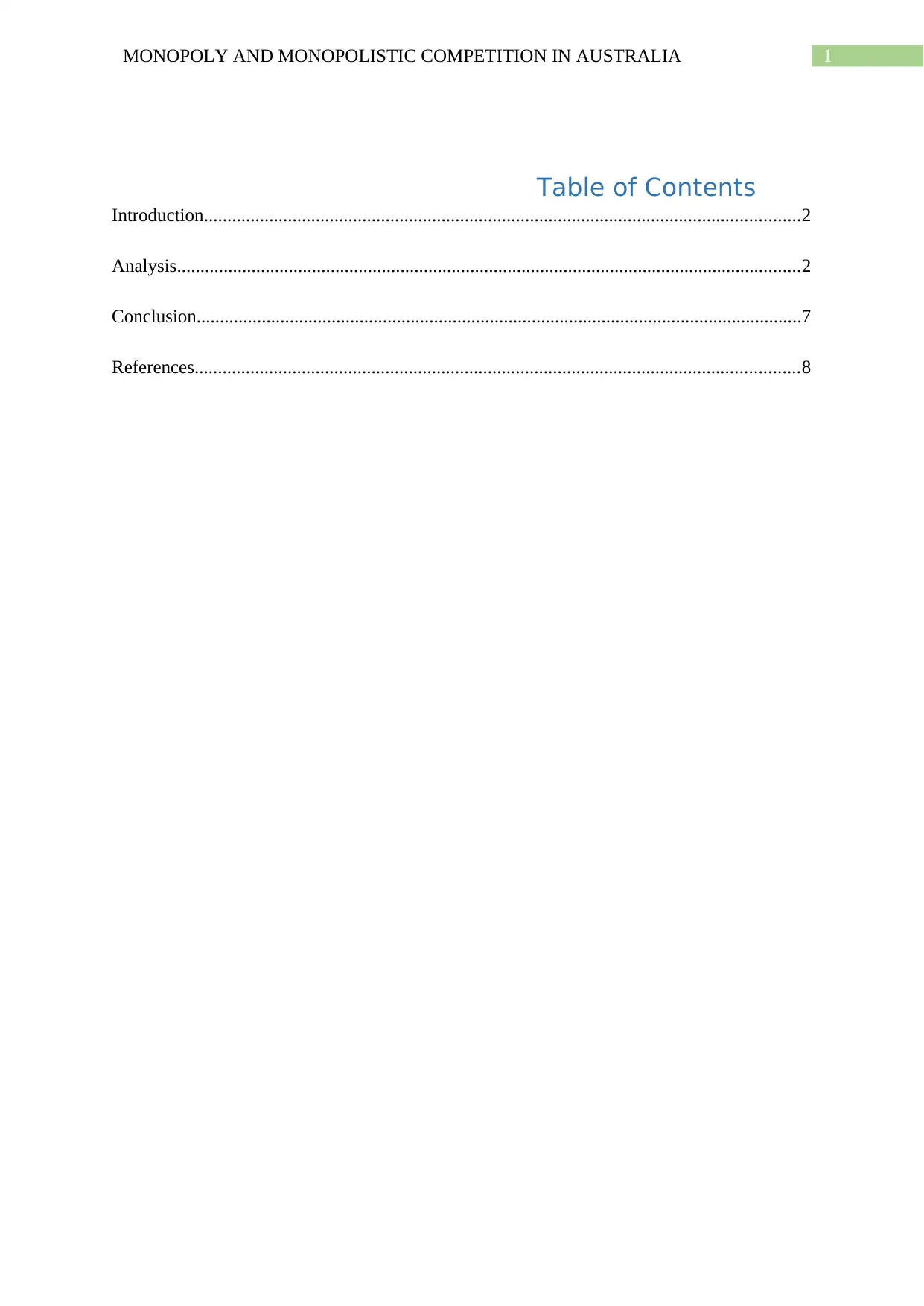
1MONOPOLY AND MONOPOLISTIC COMPETITION IN AUSTRALIA
Table of Contents
Introduction................................................................................................................................2
Analysis......................................................................................................................................2
Conclusion..................................................................................................................................7
References..................................................................................................................................8
Table of Contents
Introduction................................................................................................................................2
Analysis......................................................................................................................................2
Conclusion..................................................................................................................................7
References..................................................................................................................................8
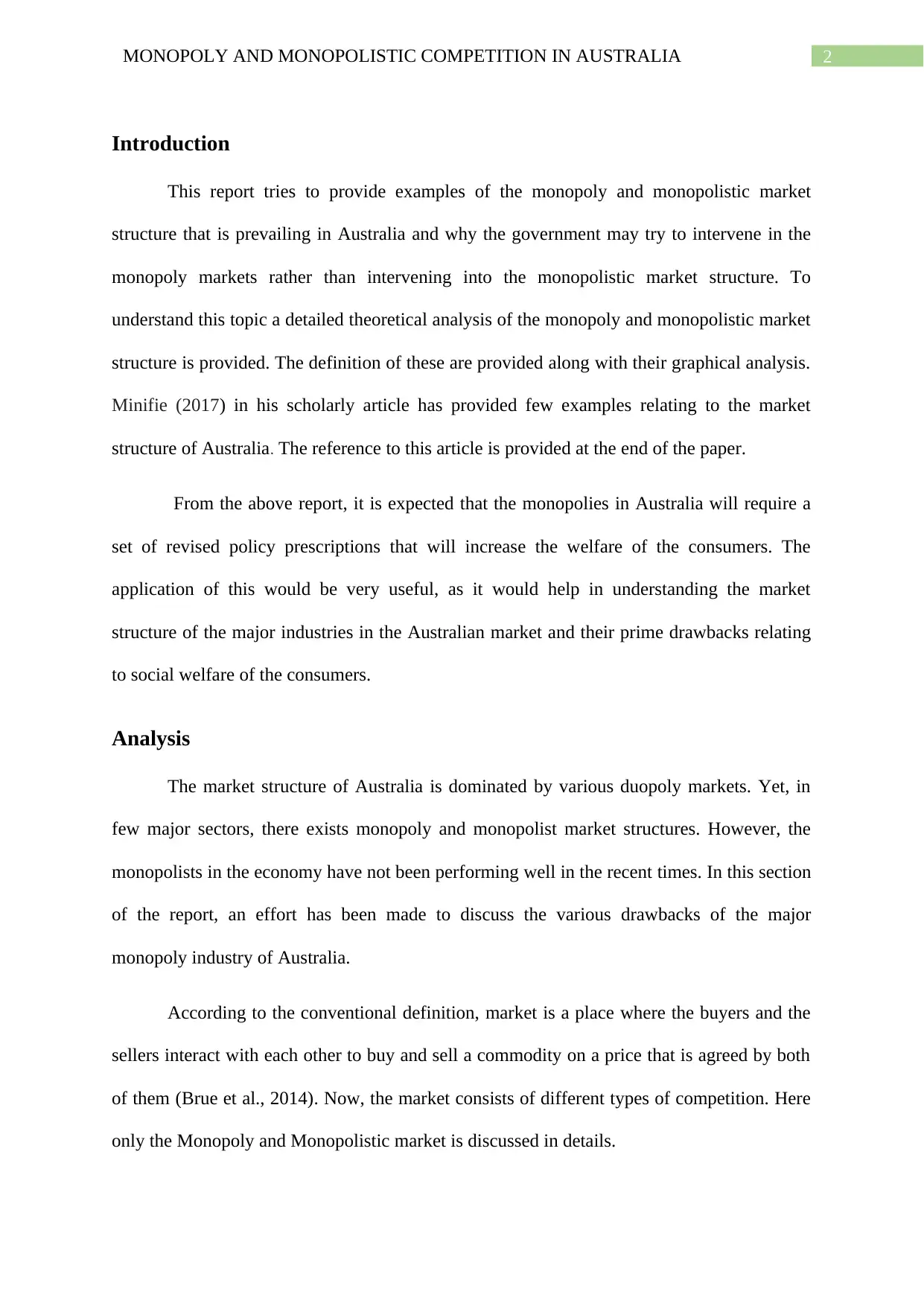
2MONOPOLY AND MONOPOLISTIC COMPETITION IN AUSTRALIA
Introduction
This report tries to provide examples of the monopoly and monopolistic market
structure that is prevailing in Australia and why the government may try to intervene in the
monopoly markets rather than intervening into the monopolistic market structure. To
understand this topic a detailed theoretical analysis of the monopoly and monopolistic market
structure is provided. The definition of these are provided along with their graphical analysis.
Minifie (2017) in his scholarly article has provided few examples relating to the market
structure of Australia. The reference to this article is provided at the end of the paper.
From the above report, it is expected that the monopolies in Australia will require a
set of revised policy prescriptions that will increase the welfare of the consumers. The
application of this would be very useful, as it would help in understanding the market
structure of the major industries in the Australian market and their prime drawbacks relating
to social welfare of the consumers.
Analysis
The market structure of Australia is dominated by various duopoly markets. Yet, in
few major sectors, there exists monopoly and monopolist market structures. However, the
monopolists in the economy have not been performing well in the recent times. In this section
of the report, an effort has been made to discuss the various drawbacks of the major
monopoly industry of Australia.
According to the conventional definition, market is a place where the buyers and the
sellers interact with each other to buy and sell a commodity on a price that is agreed by both
of them (Brue et al., 2014). Now, the market consists of different types of competition. Here
only the Monopoly and Monopolistic market is discussed in details.
Introduction
This report tries to provide examples of the monopoly and monopolistic market
structure that is prevailing in Australia and why the government may try to intervene in the
monopoly markets rather than intervening into the monopolistic market structure. To
understand this topic a detailed theoretical analysis of the monopoly and monopolistic market
structure is provided. The definition of these are provided along with their graphical analysis.
Minifie (2017) in his scholarly article has provided few examples relating to the market
structure of Australia. The reference to this article is provided at the end of the paper.
From the above report, it is expected that the monopolies in Australia will require a
set of revised policy prescriptions that will increase the welfare of the consumers. The
application of this would be very useful, as it would help in understanding the market
structure of the major industries in the Australian market and their prime drawbacks relating
to social welfare of the consumers.
Analysis
The market structure of Australia is dominated by various duopoly markets. Yet, in
few major sectors, there exists monopoly and monopolist market structures. However, the
monopolists in the economy have not been performing well in the recent times. In this section
of the report, an effort has been made to discuss the various drawbacks of the major
monopoly industry of Australia.
According to the conventional definition, market is a place where the buyers and the
sellers interact with each other to buy and sell a commodity on a price that is agreed by both
of them (Brue et al., 2014). Now, the market consists of different types of competition. Here
only the Monopoly and Monopolistic market is discussed in details.
⊘ This is a preview!⊘
Do you want full access?
Subscribe today to unlock all pages.

Trusted by 1+ million students worldwide
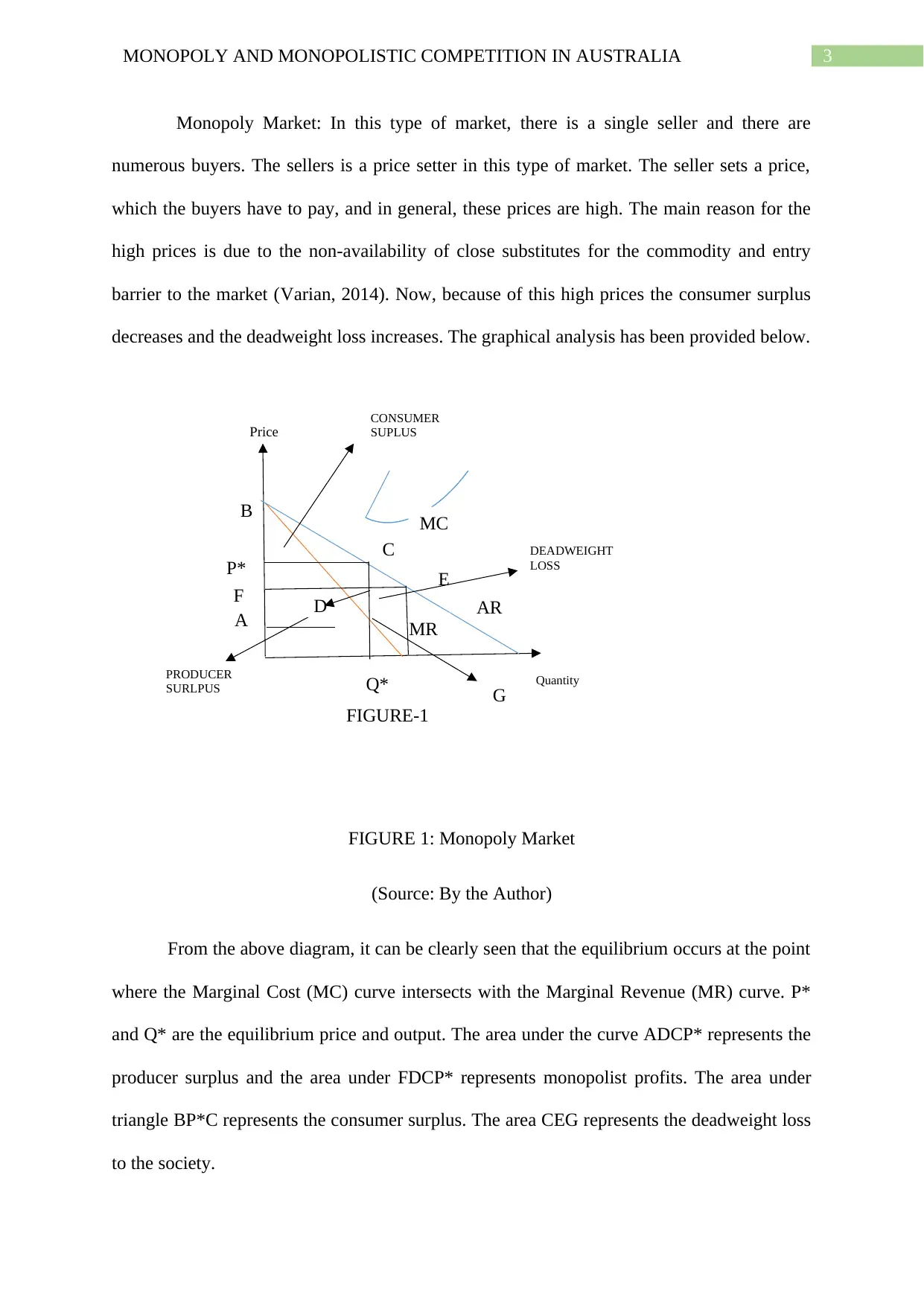
3MONOPOLY AND MONOPOLISTIC COMPETITION IN AUSTRALIA
Price
Quantity
AR
MR
MC
P*
Q*
FIGURE-1
A
B
C
D
E
CONSUMER
SUPLUS
PRODUCER
SURLPUS
DEADWEIGHT
LOSS
F
G
Monopoly Market: In this type of market, there is a single seller and there are
numerous buyers. The sellers is a price setter in this type of market. The seller sets a price,
which the buyers have to pay, and in general, these prices are high. The main reason for the
high prices is due to the non-availability of close substitutes for the commodity and entry
barrier to the market (Varian, 2014). Now, because of this high prices the consumer surplus
decreases and the deadweight loss increases. The graphical analysis has been provided below.
FIGURE 1: Monopoly Market
(Source: By the Author)
From the above diagram, it can be clearly seen that the equilibrium occurs at the point
where the Marginal Cost (MC) curve intersects with the Marginal Revenue (MR) curve. P*
and Q* are the equilibrium price and output. The area under the curve ADCP* represents the
producer surplus and the area under FDCP* represents monopolist profits. The area under
triangle BP*C represents the consumer surplus. The area CEG represents the deadweight loss
to the society.
Price
Quantity
AR
MR
MC
P*
Q*
FIGURE-1
A
B
C
D
E
CONSUMER
SUPLUS
PRODUCER
SURLPUS
DEADWEIGHT
LOSS
F
G
Monopoly Market: In this type of market, there is a single seller and there are
numerous buyers. The sellers is a price setter in this type of market. The seller sets a price,
which the buyers have to pay, and in general, these prices are high. The main reason for the
high prices is due to the non-availability of close substitutes for the commodity and entry
barrier to the market (Varian, 2014). Now, because of this high prices the consumer surplus
decreases and the deadweight loss increases. The graphical analysis has been provided below.
FIGURE 1: Monopoly Market
(Source: By the Author)
From the above diagram, it can be clearly seen that the equilibrium occurs at the point
where the Marginal Cost (MC) curve intersects with the Marginal Revenue (MR) curve. P*
and Q* are the equilibrium price and output. The area under the curve ADCP* represents the
producer surplus and the area under FDCP* represents monopolist profits. The area under
triangle BP*C represents the consumer surplus. The area CEG represents the deadweight loss
to the society.
Paraphrase This Document
Need a fresh take? Get an instant paraphrase of this document with our AI Paraphraser
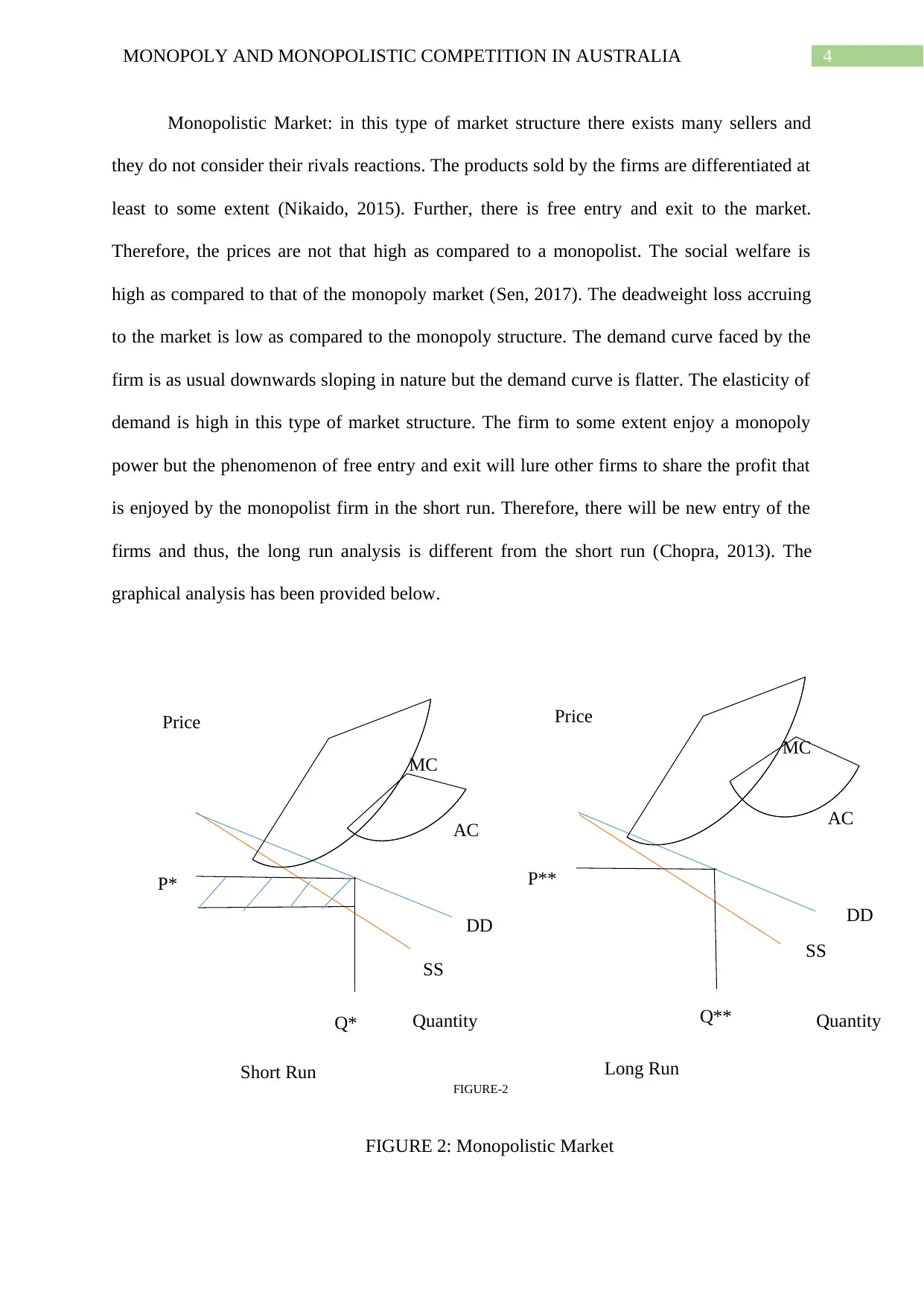
4MONOPOLY AND MONOPOLISTIC COMPETITION IN AUSTRALIA
MC
AC
DD
SS
MC
AC
DD
SS
Price
Quantity
Price
Quantity
P*
Q*
P**
Q**
Short Run Long Run
FIGURE-2
Monopolistic Market: in this type of market structure there exists many sellers and
they do not consider their rivals reactions. The products sold by the firms are differentiated at
least to some extent (Nikaido, 2015). Further, there is free entry and exit to the market.
Therefore, the prices are not that high as compared to a monopolist. The social welfare is
high as compared to that of the monopoly market (Sen, 2017). The deadweight loss accruing
to the market is low as compared to the monopoly structure. The demand curve faced by the
firm is as usual downwards sloping in nature but the demand curve is flatter. The elasticity of
demand is high in this type of market structure. The firm to some extent enjoy a monopoly
power but the phenomenon of free entry and exit will lure other firms to share the profit that
is enjoyed by the monopolist firm in the short run. Therefore, there will be new entry of the
firms and thus, the long run analysis is different from the short run (Chopra, 2013). The
graphical analysis has been provided below.
FIGURE 2: Monopolistic Market
MC
AC
DD
SS
MC
AC
DD
SS
Price
Quantity
Price
Quantity
P*
Q*
P**
Q**
Short Run Long Run
FIGURE-2
Monopolistic Market: in this type of market structure there exists many sellers and
they do not consider their rivals reactions. The products sold by the firms are differentiated at
least to some extent (Nikaido, 2015). Further, there is free entry and exit to the market.
Therefore, the prices are not that high as compared to a monopolist. The social welfare is
high as compared to that of the monopoly market (Sen, 2017). The deadweight loss accruing
to the market is low as compared to the monopoly structure. The demand curve faced by the
firm is as usual downwards sloping in nature but the demand curve is flatter. The elasticity of
demand is high in this type of market structure. The firm to some extent enjoy a monopoly
power but the phenomenon of free entry and exit will lure other firms to share the profit that
is enjoyed by the monopolist firm in the short run. Therefore, there will be new entry of the
firms and thus, the long run analysis is different from the short run (Chopra, 2013). The
graphical analysis has been provided below.
FIGURE 2: Monopolistic Market
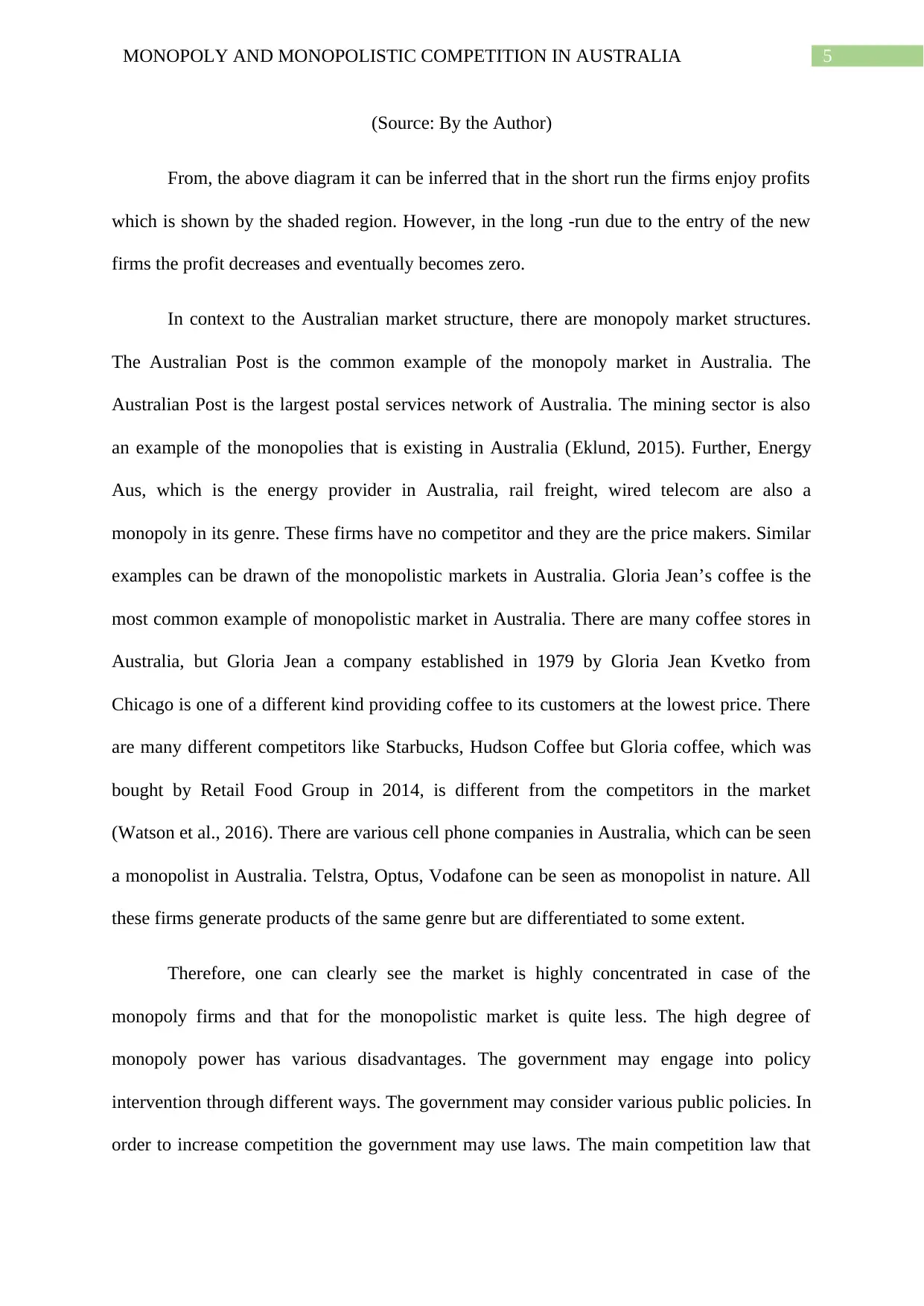
5MONOPOLY AND MONOPOLISTIC COMPETITION IN AUSTRALIA
(Source: By the Author)
From, the above diagram it can be inferred that in the short run the firms enjoy profits
which is shown by the shaded region. However, in the long -run due to the entry of the new
firms the profit decreases and eventually becomes zero.
In context to the Australian market structure, there are monopoly market structures.
The Australian Post is the common example of the monopoly market in Australia. The
Australian Post is the largest postal services network of Australia. The mining sector is also
an example of the monopolies that is existing in Australia (Eklund, 2015). Further, Energy
Aus, which is the energy provider in Australia, rail freight, wired telecom are also a
monopoly in its genre. These firms have no competitor and they are the price makers. Similar
examples can be drawn of the monopolistic markets in Australia. Gloria Jean’s coffee is the
most common example of monopolistic market in Australia. There are many coffee stores in
Australia, but Gloria Jean a company established in 1979 by Gloria Jean Kvetko from
Chicago is one of a different kind providing coffee to its customers at the lowest price. There
are many different competitors like Starbucks, Hudson Coffee but Gloria coffee, which was
bought by Retail Food Group in 2014, is different from the competitors in the market
(Watson et al., 2016). There are various cell phone companies in Australia, which can be seen
a monopolist in Australia. Telstra, Optus, Vodafone can be seen as monopolist in nature. All
these firms generate products of the same genre but are differentiated to some extent.
Therefore, one can clearly see the market is highly concentrated in case of the
monopoly firms and that for the monopolistic market is quite less. The high degree of
monopoly power has various disadvantages. The government may engage into policy
intervention through different ways. The government may consider various public policies. In
order to increase competition the government may use laws. The main competition law that
(Source: By the Author)
From, the above diagram it can be inferred that in the short run the firms enjoy profits
which is shown by the shaded region. However, in the long -run due to the entry of the new
firms the profit decreases and eventually becomes zero.
In context to the Australian market structure, there are monopoly market structures.
The Australian Post is the common example of the monopoly market in Australia. The
Australian Post is the largest postal services network of Australia. The mining sector is also
an example of the monopolies that is existing in Australia (Eklund, 2015). Further, Energy
Aus, which is the energy provider in Australia, rail freight, wired telecom are also a
monopoly in its genre. These firms have no competitor and they are the price makers. Similar
examples can be drawn of the monopolistic markets in Australia. Gloria Jean’s coffee is the
most common example of monopolistic market in Australia. There are many coffee stores in
Australia, but Gloria Jean a company established in 1979 by Gloria Jean Kvetko from
Chicago is one of a different kind providing coffee to its customers at the lowest price. There
are many different competitors like Starbucks, Hudson Coffee but Gloria coffee, which was
bought by Retail Food Group in 2014, is different from the competitors in the market
(Watson et al., 2016). There are various cell phone companies in Australia, which can be seen
a monopolist in Australia. Telstra, Optus, Vodafone can be seen as monopolist in nature. All
these firms generate products of the same genre but are differentiated to some extent.
Therefore, one can clearly see the market is highly concentrated in case of the
monopoly firms and that for the monopolistic market is quite less. The high degree of
monopoly power has various disadvantages. The government may engage into policy
intervention through different ways. The government may consider various public policies. In
order to increase competition the government may use laws. The main competition law that
⊘ This is a preview!⊘
Do you want full access?
Subscribe today to unlock all pages.

Trusted by 1+ million students worldwide
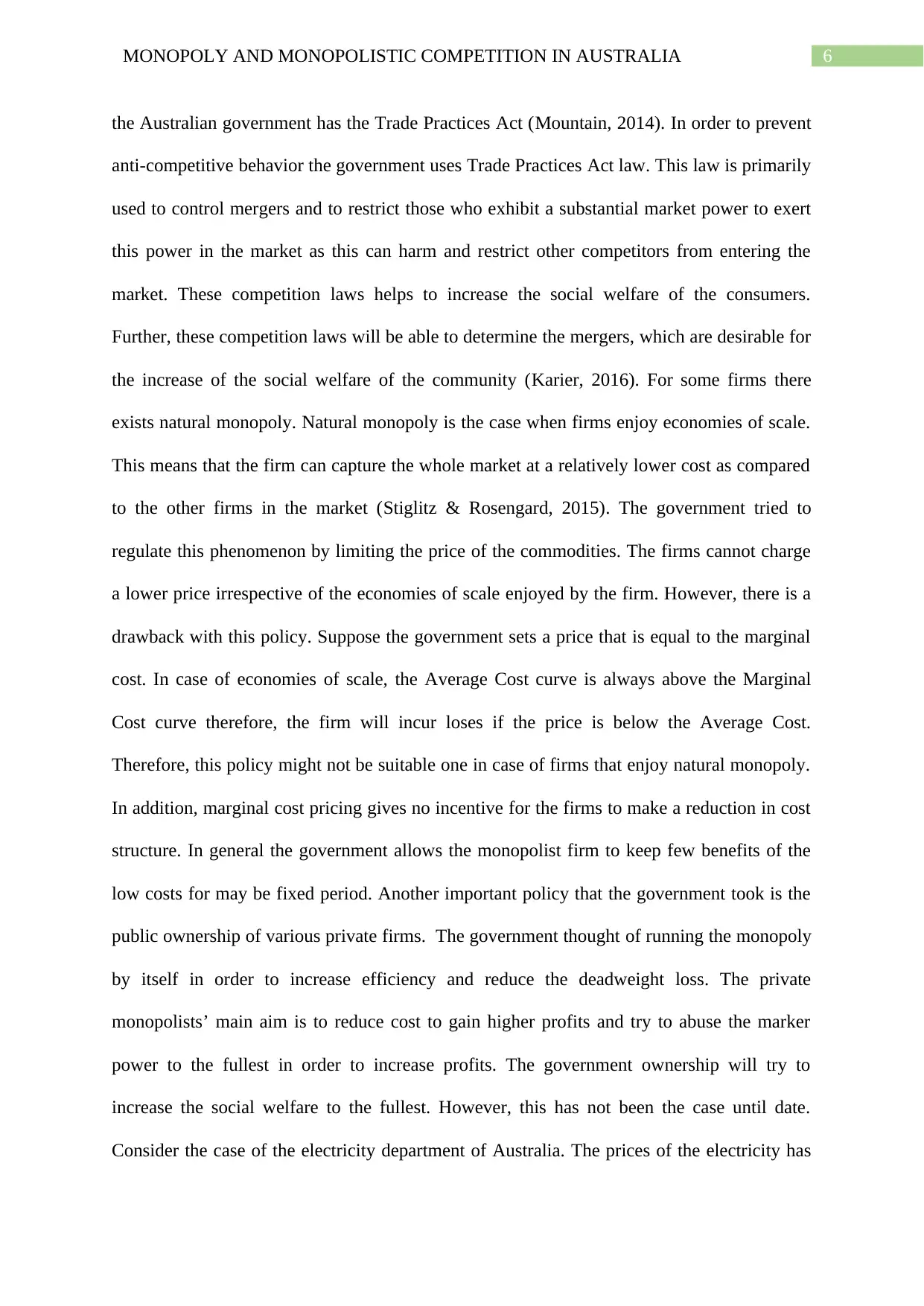
6MONOPOLY AND MONOPOLISTIC COMPETITION IN AUSTRALIA
the Australian government has the Trade Practices Act (Mountain, 2014). In order to prevent
anti-competitive behavior the government uses Trade Practices Act law. This law is primarily
used to control mergers and to restrict those who exhibit a substantial market power to exert
this power in the market as this can harm and restrict other competitors from entering the
market. These competition laws helps to increase the social welfare of the consumers.
Further, these competition laws will be able to determine the mergers, which are desirable for
the increase of the social welfare of the community (Karier, 2016). For some firms there
exists natural monopoly. Natural monopoly is the case when firms enjoy economies of scale.
This means that the firm can capture the whole market at a relatively lower cost as compared
to the other firms in the market (Stiglitz & Rosengard, 2015). The government tried to
regulate this phenomenon by limiting the price of the commodities. The firms cannot charge
a lower price irrespective of the economies of scale enjoyed by the firm. However, there is a
drawback with this policy. Suppose the government sets a price that is equal to the marginal
cost. In case of economies of scale, the Average Cost curve is always above the Marginal
Cost curve therefore, the firm will incur loses if the price is below the Average Cost.
Therefore, this policy might not be suitable one in case of firms that enjoy natural monopoly.
In addition, marginal cost pricing gives no incentive for the firms to make a reduction in cost
structure. In general the government allows the monopolist firm to keep few benefits of the
low costs for may be fixed period. Another important policy that the government took is the
public ownership of various private firms. The government thought of running the monopoly
by itself in order to increase efficiency and reduce the deadweight loss. The private
monopolists’ main aim is to reduce cost to gain higher profits and try to abuse the marker
power to the fullest in order to increase profits. The government ownership will try to
increase the social welfare to the fullest. However, this has not been the case until date.
Consider the case of the electricity department of Australia. The prices of the electricity has
the Australian government has the Trade Practices Act (Mountain, 2014). In order to prevent
anti-competitive behavior the government uses Trade Practices Act law. This law is primarily
used to control mergers and to restrict those who exhibit a substantial market power to exert
this power in the market as this can harm and restrict other competitors from entering the
market. These competition laws helps to increase the social welfare of the consumers.
Further, these competition laws will be able to determine the mergers, which are desirable for
the increase of the social welfare of the community (Karier, 2016). For some firms there
exists natural monopoly. Natural monopoly is the case when firms enjoy economies of scale.
This means that the firm can capture the whole market at a relatively lower cost as compared
to the other firms in the market (Stiglitz & Rosengard, 2015). The government tried to
regulate this phenomenon by limiting the price of the commodities. The firms cannot charge
a lower price irrespective of the economies of scale enjoyed by the firm. However, there is a
drawback with this policy. Suppose the government sets a price that is equal to the marginal
cost. In case of economies of scale, the Average Cost curve is always above the Marginal
Cost curve therefore, the firm will incur loses if the price is below the Average Cost.
Therefore, this policy might not be suitable one in case of firms that enjoy natural monopoly.
In addition, marginal cost pricing gives no incentive for the firms to make a reduction in cost
structure. In general the government allows the monopolist firm to keep few benefits of the
low costs for may be fixed period. Another important policy that the government took is the
public ownership of various private firms. The government thought of running the monopoly
by itself in order to increase efficiency and reduce the deadweight loss. The private
monopolists’ main aim is to reduce cost to gain higher profits and try to abuse the marker
power to the fullest in order to increase profits. The government ownership will try to
increase the social welfare to the fullest. However, this has not been the case until date.
Consider the case of the electricity department of Australia. The prices of the electricity has
Paraphrase This Document
Need a fresh take? Get an instant paraphrase of this document with our AI Paraphraser
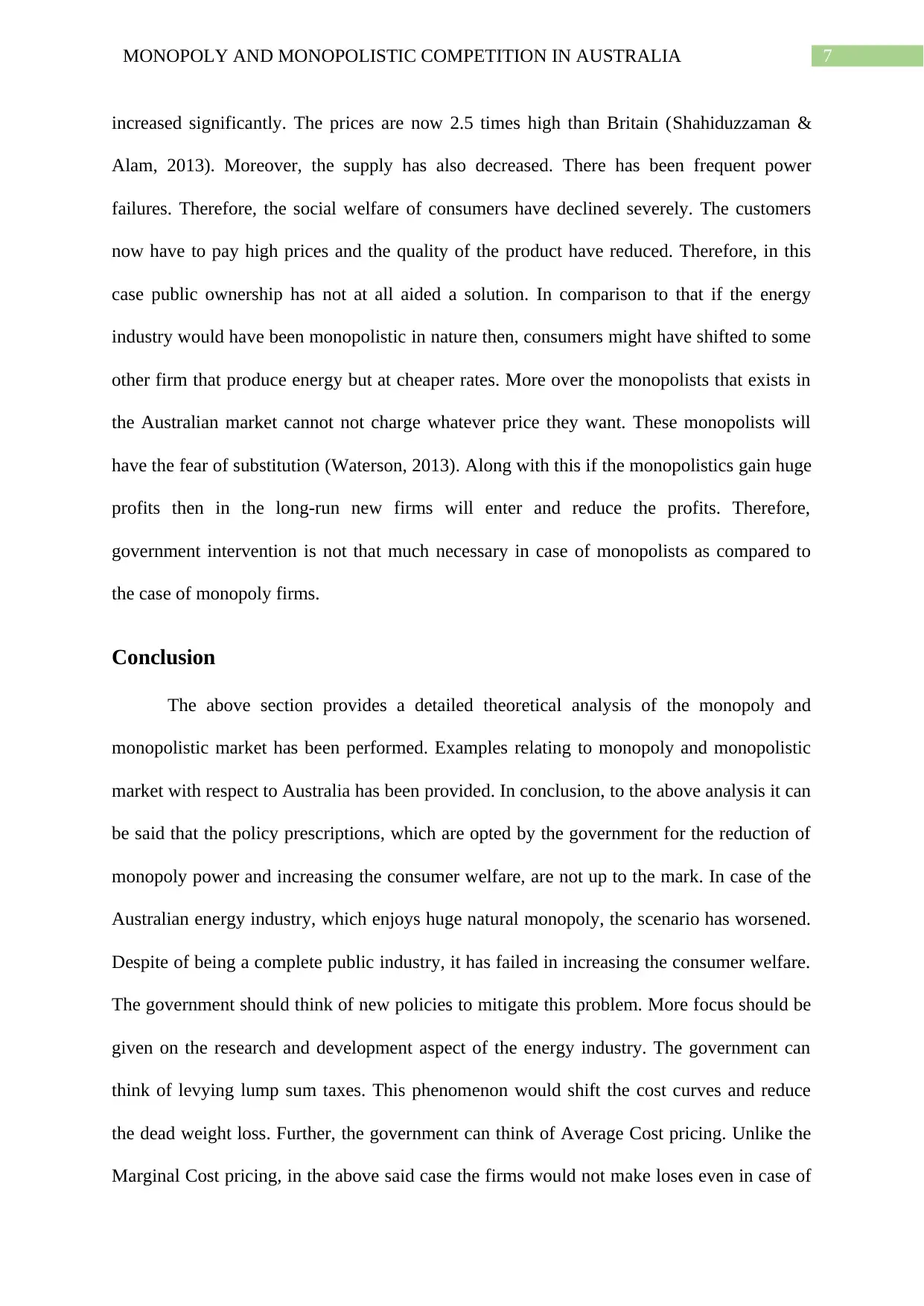
7MONOPOLY AND MONOPOLISTIC COMPETITION IN AUSTRALIA
increased significantly. The prices are now 2.5 times high than Britain (Shahiduzzaman &
Alam, 2013). Moreover, the supply has also decreased. There has been frequent power
failures. Therefore, the social welfare of consumers have declined severely. The customers
now have to pay high prices and the quality of the product have reduced. Therefore, in this
case public ownership has not at all aided a solution. In comparison to that if the energy
industry would have been monopolistic in nature then, consumers might have shifted to some
other firm that produce energy but at cheaper rates. More over the monopolists that exists in
the Australian market cannot not charge whatever price they want. These monopolists will
have the fear of substitution (Waterson, 2013). Along with this if the monopolistics gain huge
profits then in the long-run new firms will enter and reduce the profits. Therefore,
government intervention is not that much necessary in case of monopolists as compared to
the case of monopoly firms.
Conclusion
The above section provides a detailed theoretical analysis of the monopoly and
monopolistic market has been performed. Examples relating to monopoly and monopolistic
market with respect to Australia has been provided. In conclusion, to the above analysis it can
be said that the policy prescriptions, which are opted by the government for the reduction of
monopoly power and increasing the consumer welfare, are not up to the mark. In case of the
Australian energy industry, which enjoys huge natural monopoly, the scenario has worsened.
Despite of being a complete public industry, it has failed in increasing the consumer welfare.
The government should think of new policies to mitigate this problem. More focus should be
given on the research and development aspect of the energy industry. The government can
think of levying lump sum taxes. This phenomenon would shift the cost curves and reduce
the dead weight loss. Further, the government can think of Average Cost pricing. Unlike the
Marginal Cost pricing, in the above said case the firms would not make loses even in case of
increased significantly. The prices are now 2.5 times high than Britain (Shahiduzzaman &
Alam, 2013). Moreover, the supply has also decreased. There has been frequent power
failures. Therefore, the social welfare of consumers have declined severely. The customers
now have to pay high prices and the quality of the product have reduced. Therefore, in this
case public ownership has not at all aided a solution. In comparison to that if the energy
industry would have been monopolistic in nature then, consumers might have shifted to some
other firm that produce energy but at cheaper rates. More over the monopolists that exists in
the Australian market cannot not charge whatever price they want. These monopolists will
have the fear of substitution (Waterson, 2013). Along with this if the monopolistics gain huge
profits then in the long-run new firms will enter and reduce the profits. Therefore,
government intervention is not that much necessary in case of monopolists as compared to
the case of monopoly firms.
Conclusion
The above section provides a detailed theoretical analysis of the monopoly and
monopolistic market has been performed. Examples relating to monopoly and monopolistic
market with respect to Australia has been provided. In conclusion, to the above analysis it can
be said that the policy prescriptions, which are opted by the government for the reduction of
monopoly power and increasing the consumer welfare, are not up to the mark. In case of the
Australian energy industry, which enjoys huge natural monopoly, the scenario has worsened.
Despite of being a complete public industry, it has failed in increasing the consumer welfare.
The government should think of new policies to mitigate this problem. More focus should be
given on the research and development aspect of the energy industry. The government can
think of levying lump sum taxes. This phenomenon would shift the cost curves and reduce
the dead weight loss. Further, the government can think of Average Cost pricing. Unlike the
Marginal Cost pricing, in the above said case the firms would not make loses even in case of
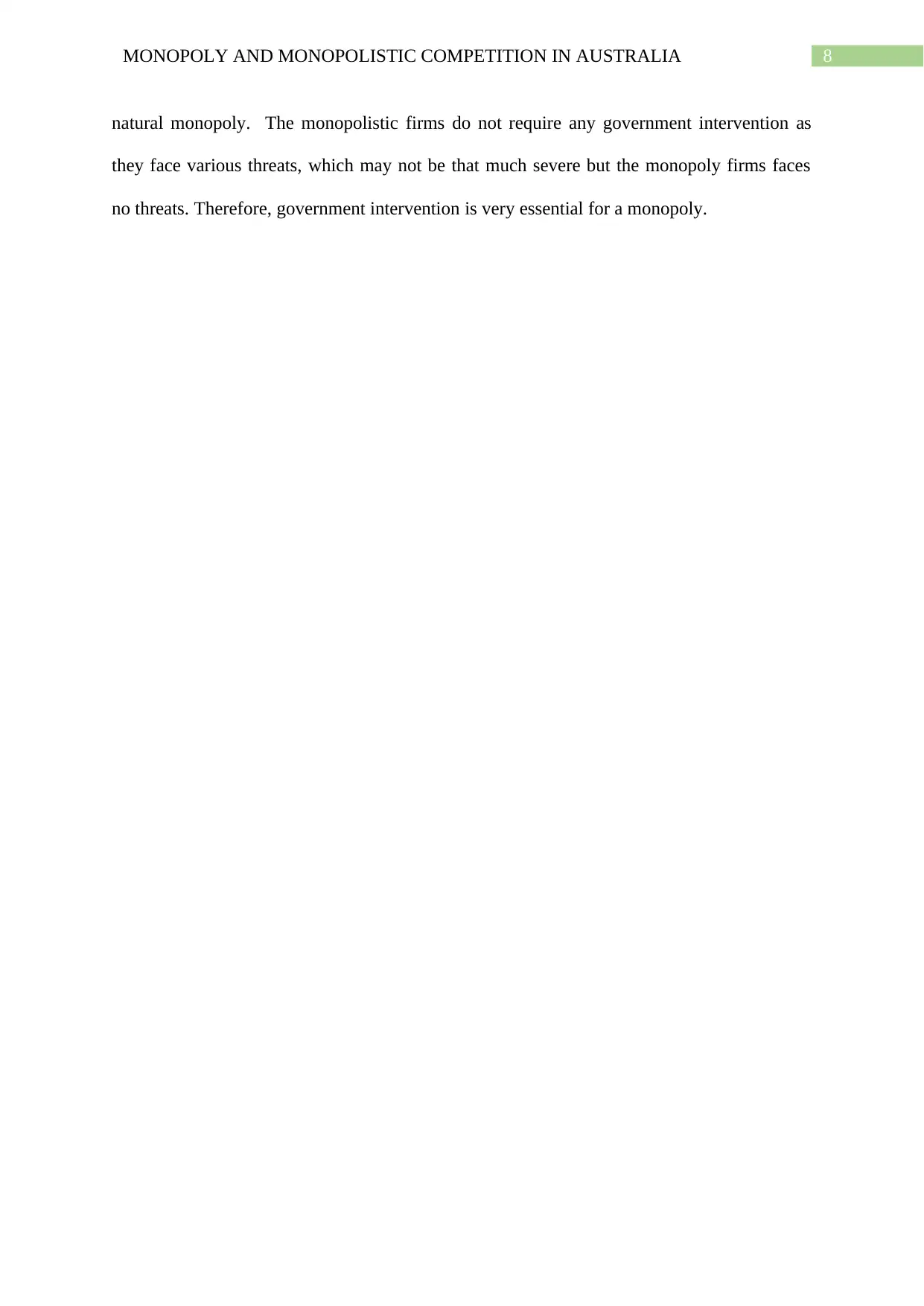
8MONOPOLY AND MONOPOLISTIC COMPETITION IN AUSTRALIA
natural monopoly. The monopolistic firms do not require any government intervention as
they face various threats, which may not be that much severe but the monopoly firms faces
no threats. Therefore, government intervention is very essential for a monopoly.
natural monopoly. The monopolistic firms do not require any government intervention as
they face various threats, which may not be that much severe but the monopoly firms faces
no threats. Therefore, government intervention is very essential for a monopoly.
⊘ This is a preview!⊘
Do you want full access?
Subscribe today to unlock all pages.

Trusted by 1+ million students worldwide
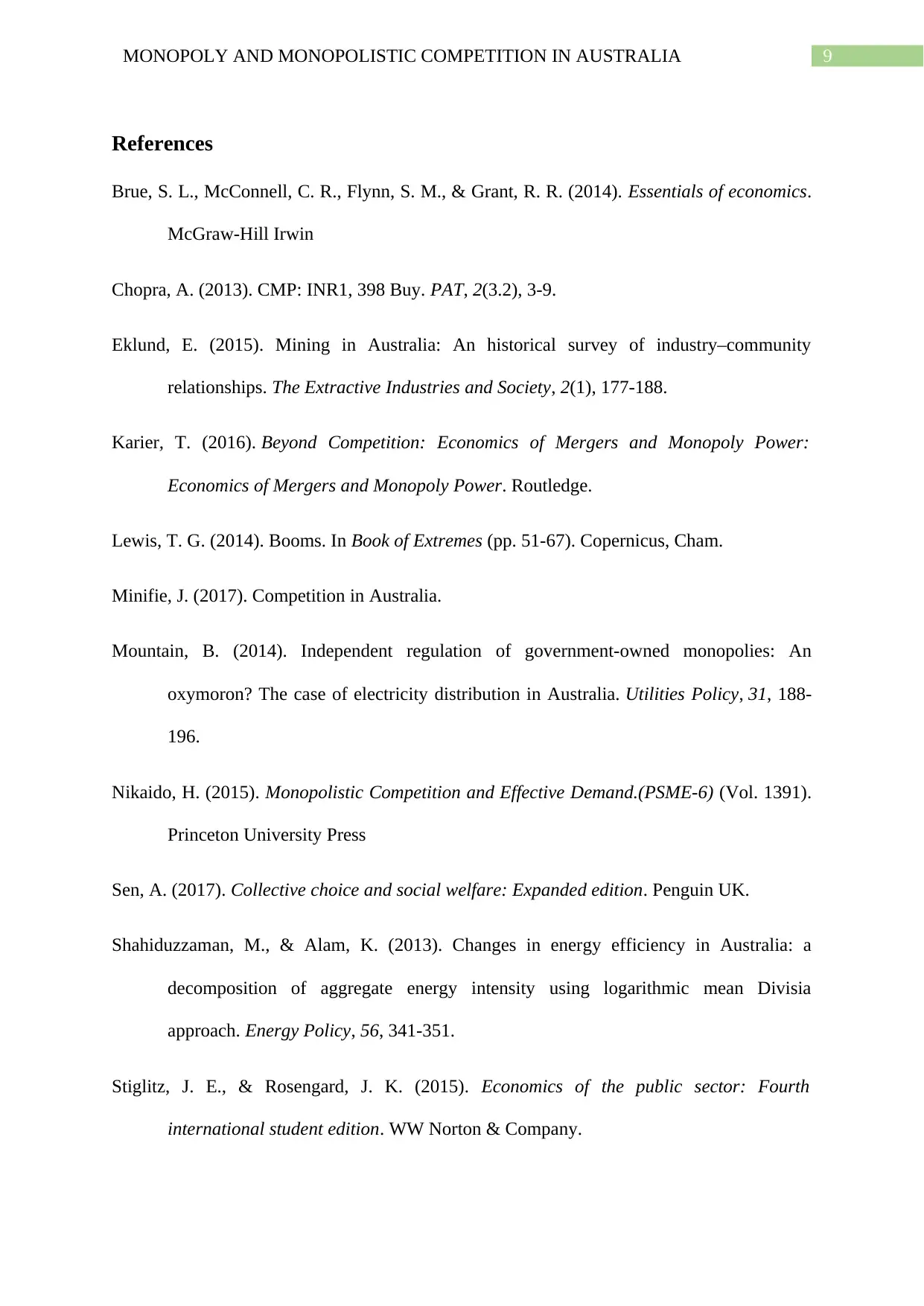
9MONOPOLY AND MONOPOLISTIC COMPETITION IN AUSTRALIA
References
Brue, S. L., McConnell, C. R., Flynn, S. M., & Grant, R. R. (2014). Essentials of economics.
McGraw-Hill Irwin
Chopra, A. (2013). CMP: INR1, 398 Buy. PAT, 2(3.2), 3-9.
Eklund, E. (2015). Mining in Australia: An historical survey of industry–community
relationships. The Extractive Industries and Society, 2(1), 177-188.
Karier, T. (2016). Beyond Competition: Economics of Mergers and Monopoly Power:
Economics of Mergers and Monopoly Power. Routledge.
Lewis, T. G. (2014). Booms. In Book of Extremes (pp. 51-67). Copernicus, Cham.
Minifie, J. (2017). Competition in Australia.
Mountain, B. (2014). Independent regulation of government-owned monopolies: An
oxymoron? The case of electricity distribution in Australia. Utilities Policy, 31, 188-
196.
Nikaido, H. (2015). Monopolistic Competition and Effective Demand.(PSME-6) (Vol. 1391).
Princeton University Press
Sen, A. (2017). Collective choice and social welfare: Expanded edition. Penguin UK.
Shahiduzzaman, M., & Alam, K. (2013). Changes in energy efficiency in Australia: a
decomposition of aggregate energy intensity using logarithmic mean Divisia
approach. Energy Policy, 56, 341-351.
Stiglitz, J. E., & Rosengard, J. K. (2015). Economics of the public sector: Fourth
international student edition. WW Norton & Company.
References
Brue, S. L., McConnell, C. R., Flynn, S. M., & Grant, R. R. (2014). Essentials of economics.
McGraw-Hill Irwin
Chopra, A. (2013). CMP: INR1, 398 Buy. PAT, 2(3.2), 3-9.
Eklund, E. (2015). Mining in Australia: An historical survey of industry–community
relationships. The Extractive Industries and Society, 2(1), 177-188.
Karier, T. (2016). Beyond Competition: Economics of Mergers and Monopoly Power:
Economics of Mergers and Monopoly Power. Routledge.
Lewis, T. G. (2014). Booms. In Book of Extremes (pp. 51-67). Copernicus, Cham.
Minifie, J. (2017). Competition in Australia.
Mountain, B. (2014). Independent regulation of government-owned monopolies: An
oxymoron? The case of electricity distribution in Australia. Utilities Policy, 31, 188-
196.
Nikaido, H. (2015). Monopolistic Competition and Effective Demand.(PSME-6) (Vol. 1391).
Princeton University Press
Sen, A. (2017). Collective choice and social welfare: Expanded edition. Penguin UK.
Shahiduzzaman, M., & Alam, K. (2013). Changes in energy efficiency in Australia: a
decomposition of aggregate energy intensity using logarithmic mean Divisia
approach. Energy Policy, 56, 341-351.
Stiglitz, J. E., & Rosengard, J. K. (2015). Economics of the public sector: Fourth
international student edition. WW Norton & Company.
Paraphrase This Document
Need a fresh take? Get an instant paraphrase of this document with our AI Paraphraser
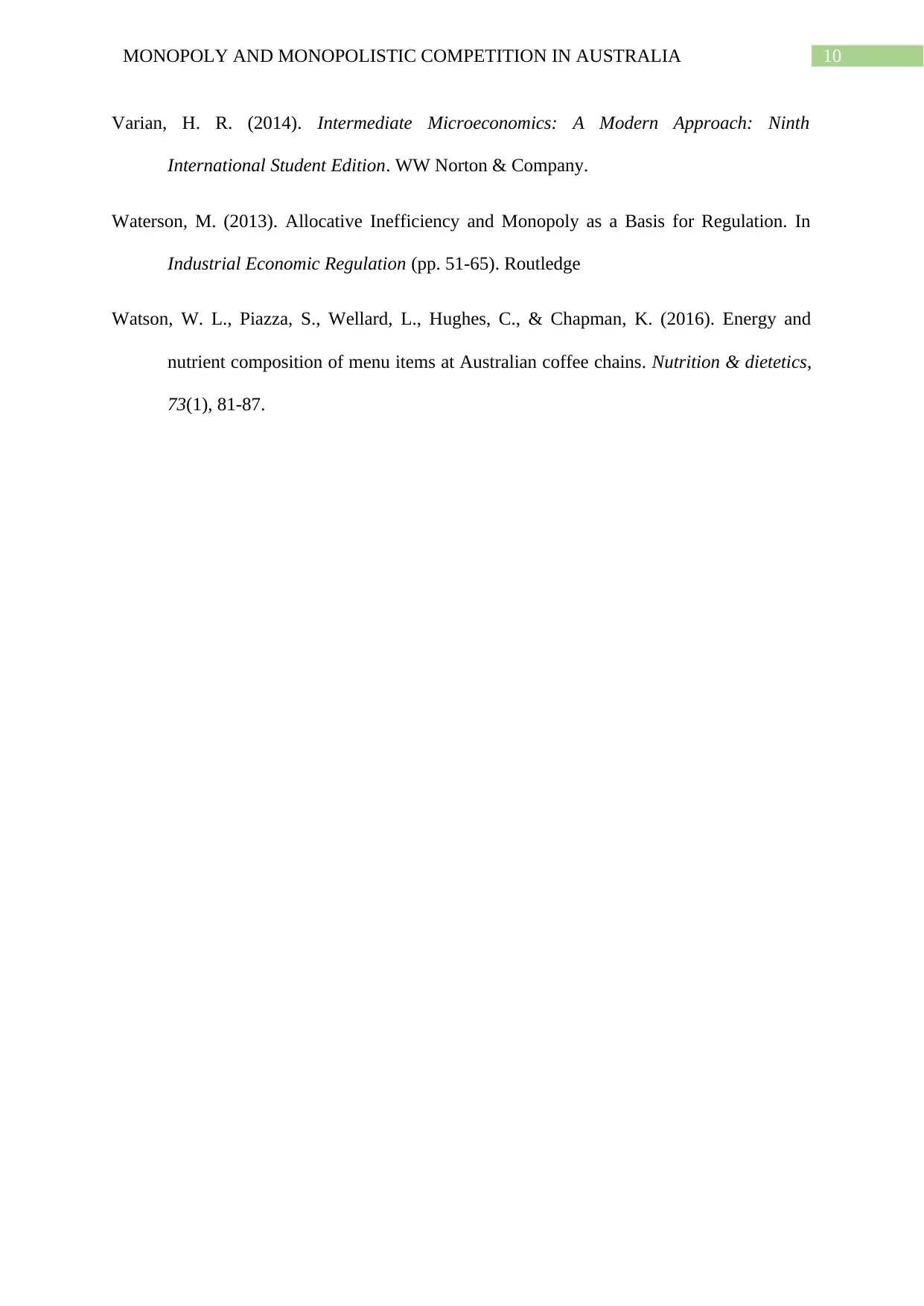
10MONOPOLY AND MONOPOLISTIC COMPETITION IN AUSTRALIA
Varian, H. R. (2014). Intermediate Microeconomics: A Modern Approach: Ninth
International Student Edition. WW Norton & Company.
Waterson, M. (2013). Allocative Inefficiency and Monopoly as a Basis for Regulation. In
Industrial Economic Regulation (pp. 51-65). Routledge
Watson, W. L., Piazza, S., Wellard, L., Hughes, C., & Chapman, K. (2016). Energy and
nutrient composition of menu items at Australian coffee chains. Nutrition & dietetics,
73(1), 81-87.
Varian, H. R. (2014). Intermediate Microeconomics: A Modern Approach: Ninth
International Student Edition. WW Norton & Company.
Waterson, M. (2013). Allocative Inefficiency and Monopoly as a Basis for Regulation. In
Industrial Economic Regulation (pp. 51-65). Routledge
Watson, W. L., Piazza, S., Wellard, L., Hughes, C., & Chapman, K. (2016). Energy and
nutrient composition of menu items at Australian coffee chains. Nutrition & dietetics,
73(1), 81-87.
1 out of 11
Related Documents
Your All-in-One AI-Powered Toolkit for Academic Success.
+13062052269
info@desklib.com
Available 24*7 on WhatsApp / Email
![[object Object]](/_next/static/media/star-bottom.7253800d.svg)
Unlock your academic potential
Copyright © 2020–2025 A2Z Services. All Rights Reserved. Developed and managed by ZUCOL.


